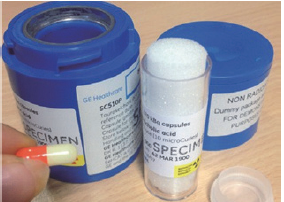Download and print as a PDF (428kB pdf)
On this page
- What is a SeHCAT scan?
- Can I have a SeHCAT study if I am pregnant?
- Can I have a SeHCAT study if I am breastfeeding or chest/bottle-feeding?
- Can I have a SeHCAT test if I am on dialysis?
- Can I bring someone with me?
- Do I need to stop my medication?
- What will happen at my first appointment?
- What happens after my first appointment?
- What will happen at my second appointment?
- What happens after my appointment?
- When will I get my results?
- Are there any risks with this procedure?
- Contact Details
What is a SeHCAT scan?
A SeHCAT scan (pronounced “see cat”) is a diagnostic test to investigate how well your gut is able to absorb bile acids, which help to digest fats and eliminate toxins from the body. If the absorption is poor (know as BAM – Bile Acid Malabsorption), this can result in chronic (long-term) diarrhoea. This test may also be used to assess ileal function, inflammatory bowel disease & chronic diarrhoea, and in the study of enterohepatic circulation.
Be aware
Having a SeHCAT scan requires you to attend two appointments, seven days apart.
Note: If you are living with a disability resulting from a missing limb, or if you have difficulty in lying flat for a short period, please speak to one of the nuclear medicine team as you may need to be imaged on the scanner during your first appointment.
Can I have a SeHCAT study if I am pregnant?
If there is a possibility that you are pregnant, please inform the department before your appointment. This should not affect your appointment.
Can I have a SeHCAT study if I am breastfeeding or chest/bottle-feeding?
Please inform the department before your appointment if you are currently breastfeeding or bottle-feeding your breastmilk to your child, or chest-feeding or bottle-feeding formula milk.
Can I have a SeHCAT test if I am on dialysis?
Please inform the department if you are on any form of dialysis, as it may be necessary to co-ordinate your nuclear medicine appointment with your dialysis treatment.
Can I bring someone with me?
Whenever possible, please attend your appointment alone, unless you need a carer to support any additional needs.
Do I need to stop my medication?
If you are taking any of these medications, please stop these the day before your first appointment and only start again after your second appointment:
- Loperamide (Immodium)
- Cholestyramine (Questran, Prevalite)
- Colesevelam (Welchol)
- Colestipol (Colestid, Colestipid)
- Any other medications that affect bowel motility

What will happen at my first appointment?
We will measure your height and weight – please avoid wearing heavy clothing or accessories. You will also be asked to remove your footwear.
If you wear a catheter or stoma bag, please try to empty these before we weigh you. Similarly, if you wear incontinence pads or pants, please change these before your appointment, as they may add extra weight.
After your weight and height have been measured, you will be given a cup of water and asked to swallow a capsule which contains a small amount of a radioactive tracer. We will measure how much of this tracer is left in your body when you return for your second appointment in 7 days’ time.
Be aware
The radioactive capsule contains gelatine. Please let us know as soon as possible if this conflicts with any dietary requirements.
After swallowing the capsule, you will be free to leave the department immediately. The capsule will not make you feel any different or affect your ability to drive home.
What happens after my first appointment?
You will not need to keep your distance from other people following your appointment.
What will happen at my second appointment?
When you return on day 7 you will not have to swallow a capsule beforehand, or have your height and weight measured again. Instead, we will ask you to lie still for five minutes while we take our pictures using our gamma camera.
You do not usually have to undress but we will ask you to remove any metal objects from around your abdomen and in your pockets, such as phones, belts, keys, coins etc
After this, the nuclear medicine technologist will ask you to wait for a few minutes while they check the images from your scan.

What happens after my appointment?
After each appointment you can resume all usual activities. Eat as normal and keep well hydrated.
When will I get my results?
A report will be sent to your referring doctor who should contact you to discuss the results. If you have any questions regarding your results, please contact the doctor who referred you.
Are there any risks with this procedure?
The radioactive tracer administered will expose you to a small amount of ionising radiation, consistent with the desired diagnostic outcome. This radiation dose is equivalent to approximately 1-2 months of natural background radiation in the Sussex region.
The radiation risks to you are considered to be very low while the potential benefits of having this test, such as helping your doctor to decide on the best treatment for you, greatly outweigh those small risks.
The risks to others from the small amount of radiation you will be emitting is even smaller and can be considered negligible.
Contact Details
Royal Sussex County Hospital (RSCH)
Nuclear Medicine Department
Louisa Martindale Building, Royal Sussex County Hospital
Eastern Road, Brighton BN2 5BE
01273 696955
Ext. 64381 or 64382
Princess Royal Hospital (PRH)
Imaging Department
Nuclear Medicine Department
Lewes Road, Haywards Heath
West Sussex RH16 4EX
Disclaimer
This leaflet is intended for patients receiving care in Brighton & Hove or Haywards Heath.
The information in this leaflet is for guidance purposes only and is in no way intended to replace professional clinical advice by a qualified practitioner.